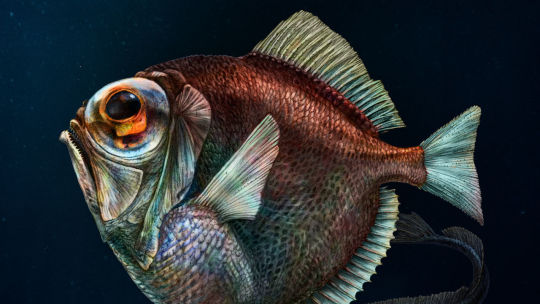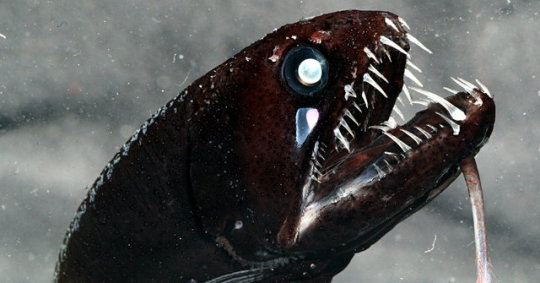#silver spinyfin
Text
Daily fish fact #749
Silver spinyfin!

This fish has hardly a reason to be sad: it has the largest amount of rod opsin genes of any vertebrate! An opsin is a protein that is activated when it comes in contact with a certain wavelength of light, they are used in photoreceptor cells and allow us and other animals to see. To revise, two of the most significant types of photoreceptor cells in the eyes of a vertebrate are cones, which allow us to see in colour, and rods, which function in low light and allow us to see in the dark.
For the longest time, it was thought that vertebrates in general have just one type of rod opsin with one gene producing it (most do), but the silver spinyfin, a deep sea fish, is fascinating in that it has 38 genes for rod opsin! It can express 14 of those genes, and this selection of different rod opsins allows the silver spinyfin to see wavelengths between 445 and 520 nanometers, which encompasses much of blue light! In a strange twist, the silver spinyfin can see colour using its rod cells, likely to spot bioluminescence in the deep and dark ocean.
#well this is a big fact!#but exciting discovery no? its not particularly new but...#fish#fishfact#fish facts#fishblr#marine life#marine biology#marine animals#sea animals#sea creatures#sea life#deep sea creatures#deep sea#deep sea life#deep sea fish#biology#zoology#silver spinyfin#dead animal#animal death#cw animal death
228 notes
·
View notes
Photo

Silver spinyfin: lives in the gloom, 2000 meters down.
Pavel Riha/University of South Bohemia
1 note
·
View note
Link
“We’re at the edge of our human knowledge about this species,” Musilova says in agreement. Nevertheless, to her the results illustrate the diversity of strategies fish have evolved to survive in the deep sea. Some, such as anglerfish, have evolved a sophisticated symbiosis with bacteria to create a bioluminescent lure to attract prey. Others, including lanternfish, migrate periodically between shallow waters to feed and deeper waters for safety. And it appears that the silver spinyfin’s strategy has been to simply invest in vision: It happens to have one of the thickest retinas among fish species, which consists of several layers of rods, she says. “They might be real masters of vision in the deep sea.”
So this little is likely to actually see colors at depths where we could see absolutely nothing.
1 note
·
View note
Link
Some fishes in the deep, dark sea may see their world in more than just shades of gray.
A survey of 101 fish species reveals that four from the deep sea had a surprising number of genes for light-sensitive eye proteins called rod opsins, researchers report in the May 10 Science. Depending on how the animals use those light catchers, the discovery might challenge the widespread idea that deep-sea fishes don’t see color, says coauthor Zuzana Musilová, an evolutionary biologist at Charles University in Prague.
To see, many fishes, humans and most other vertebrates rely on two types of light-detecting cells in the eye known as rods and cones. Cone cells use two or more kinds of opsins and need decent amounts of light to work. Rods generally use only one opsin called RH1, which works in dim light. That variety in opsins in cones, but not in rods, lets vertebrates see a range of colors in well-lit conditions but be color-blind in the near dark.
In the new study, Musilová and Fabio Cortesi of the University of Queensland in Brisbane, Australia sailed on research ships equipped to reach into the ocean depths for fish. The deep-sea specimens came from the “twilight” zone 200 to 1,000 meters below the surface, where sunlight becomes only a subtle lessening of darkness. The most colorful things to look at would be bioluminescent spots on animals’ bodies.
The four deep-sea fishes with the special eyes came from three different lineages that had independently evolved genes for more than one kind of RH1 rod opsin, Musilová, Cortesi and their colleagues report. A glacier lantern fish (Benthosema glaciale) had genes for five different forms of RH1, and a tube-eye (Stylephorus chordatus) had six. Two kinds of spinyfin had even more, 18 genes for the longwing spinyfin (Diretmoides pauciradiatus) and a stunning 38 for the silver spinyfin (Diretmus argenteus).
Finding even two rod opsins would have been notable, but the silver spinyfin’s tally is “astounding,” says evolutionary biologist Megan Porter at the University of Hawaii at Manoa, who was not involved in the new research. But she and others warn against jumping to conclusions about how fishes use all this variety, because there are no tests with fish behavior.
Considering where these fishes live, such tests may not even be possible, Musilová says. When brought to the surface, “most of them simply die due to the pressures changes,” she says. “Even getting them to the surface alive doesn’t guarantee they would behave the same way they do in the depths.”
The fish that the researchers caught let them check which opsin genes were actually turned on in the animals’ retinas. That work confirmed that the silver spinyfin actually uses at least 14 of its 38 RH1 genes to make proteins.
The researchers also put the silver spinyfin’s various RHI genes into bacteria, which manufactured fish opsins. Tests of those opsins’ function showed they have the potential to capture both very faint daylight and a wide range of blue and green light from living bioluminescent creatures, the scientists found.
Overall, the authors are rightly “cautious” in not claiming that deep-sea fish can see color, says Almut Kelber of Lund University in Sweden, who has studied low-light color vision in frogs.
The new fish results, for example, don’t say whether different RHI opsins cluster in individual rod cells or are scattered, with different rod cells carrying different opsins. To differentiate colors, the rod opsins would need to be in different cells. But if the proteins clump in each rod, then the fish probably just have enhanced sensitivity to light and could pick out fainter objects in shades of black and white.
Even with the uncertainties, finding all these unexpected opsins “is still exciting,” Kelber says.
#science#scied#sciblr#opsin#deep-sea fish#deep-sea#oceans#spinyfin#rod opsins#biology#marine biology
76 notes
·
View notes
Link
Scientists have generally understood that color vision wasn’t necessary in the deep sea. It’s too far for sunbeams to penetrate, and so there’s no light to give way to color. But researchers interested in the evolution of color vision analyzed the genomes of 101 different fishes. They discovered that one, the silver spinyfin, has more genes for discriminating dull light than any other vertebrate on the planet. These genes make it possible to see the whole range of residual daylight and the full spectrum of bioluminescence in the deep sea. Other fishes may have this ability to detect color in the deep sea, too.
“In vertebrate fishes, nothing has been seen like this before,” said Megan Porter, who studies how vision evolved at the University of Hawaii at Mānoa and was not involved in the research. “This goes against what we understood as how visual systems evolved in the deep sea, which means we have to question how visual systems work and function in the dim light.”
29 notes
·
View notes
Text
Nelle profondita oceaniche, nel buio più profondo, alcuni pesci hanno evoluto una super-vista
Nelle profondita oceaniche, nel buio più profondo, alcuni pesci hanno evoluto una super-vista

Vivendo nell’oscurità a 2000 metri di profondità, il silver spinyfin può distinguere i colori.
Quando gli antenati dei pesci cavernicoli e di certi grilli si trasferirono nelle caverne buie come la pece, i loro occhi scomparvero nel corso delle generazioni. Ma i pesci che solcano il mare a profondità maggiori di quelle in cui possa penetrare la luce del sole hanno sviluppato una…
View On WordPress
0 notes
Photo

How Fish May See Color in the Deep Ocean’s Darkness The silver spinyfin, or little dori, inhabits a layer of the deep sea, where the Twilight Zone’s blue fades to black, often half a mile below the surface.
0 notes
Text
The Allure Of Shiny Things
The Allure Of Shiny Things - #doodlewashOctober2019 #Inktober #Inktober2019 #watercolor #spinyfish #bait
For our Doodlewash prompt of “Fish” today, paired with the Inktober prompt of “Bait,” I ended up with this little silver spinyfin. A fish I would place in the ugly-cute category, much like E.T. The Extraterrestrial. And there’s certainly a lot of aliens waiting to be found in the ocean depths. I’d not really heard of this fish before, but saw an article recently that said that this big-eyed deep…
View On WordPress
#doodlewashOctober2019#WorldWatercolorGroup#doodlewash#drawing#fish#Inktober#inktober 2019#pen and ink#sketchbook#sketching#watercolor#watercolour
0 notes
Text
科學家發現不少深海怪魚可能擁有不俗的視力
這項研究結果已於5月10日發表在《Science Advances》上。據了解,研究小組通過對101個物種的基因組的分析發現,其中13個擁有能夠感知顏色的基因。其中一個物種,銀色洞鰭鯛(silver spinyfin)擁有大量可能意味著它可以接收許多不同波長光的基因。
“這是第一篇研究各種魚類並發現它們的視覺系統的多樣和多變的論文,”該論文的合著者Karen Carleton在一份新聞稿中說。
據了解,脊椎動物使用一種叫做視蛋白(能夠吸收光線)的特殊蛋白質來進行感光。對此,研究小組觀察了一種特殊類型的視蛋白,它能低光環境具備感光能力。科學家們懷疑很多魚只有一個視蛋白基因,這意味著它們不能辨別顏色。但研究小組在這項研究中觀察的物種中卻有13個物種擁有不止一種視蛋白,前面提到的銀色洞鰭鯛則有著驚人的38種。
之後,科學家們通過模擬的方式對這些視蛋白進行測試,看看它們是否能“看到”光的波長。他們懷疑,像銀色洞鰭鯛等這樣的魚類能夠探測到非常微弱的光線。
“如果你想在那裡生存下去,你需要快速決定你看到的是潛在的捕食者還是潛在的獵物,”論文的合著者Fabio Cortesi說道。
針對這項研究,研究小組則提出了幾個關於深海色覺擴散的情景。在銀色洞鰭鯛中發現的38種視蛋白基因上很有可能是在其生命不同階段開啟的。
無論情況如何都需要科學家們展開進一步的工作才能了解這些現象背後的真正故事。
.(tagsToTranslate)科學探索(t)科學家發現不少深海怪魚可能擁有不俗的視力(t)cnBeta
from http://bit.ly/2V9E3PL
0 notes